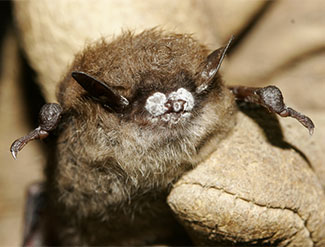Bats and Wind Turbines Don’t Mix
By Chris Williams on October 16, 2014.
 For years, researchers have known that those giant wind turbines kill migrating bats (and birds, but that’s another story). What they haven’t exactly understood is why.
For years, researchers have known that those giant wind turbines kill migrating bats (and birds, but that’s another story). What they haven’t exactly understood is why.
We’re not talking about just a few bats, up to 900,000 bats are killed by wind turbines each year. A team of bat experts led by the U.S. Geologial Survey set up thermal video surveillance cameras to study bats night after night at a wind farm in Indiana.
Then answer to “why” turned out to be more straight-forward than anyone could have guessed. Bats have lousy vision. Sure they can pick all those tiny insects out of the air while swooping and turning, but they don’t rely on vision. It’s their built-in sonar that allows them to “see” what’s out there. And what they see when they detect a wind turbine in front of them is a tree that is very tall with a big round trunk.
It’s a Bird, It’s a Plane, It’s a Tree?
Some species of bats, like the hoary bat studied, socialize and roost in trees, as opposed to other migrating bats that group in caves. These tree bats, with their dim vision, will approach and investigate tall things shaped like trees. It’s also theorized that the males look for the tallest tree around to attract a mate.
These faux “trees” generate airflow paths that bats follow. At one wind farm with 600 turbines, researchers watched as bats soared and dived and chased each other through the turbine field, much as they might do in a grove of trees. But these trees have very unfriendly, hard, moving leaves. And even with their sonar that allows them to avoid most obstacles, bats don’t always make it.
Researchers aren’t recommending that we do away with wind turbines, but they are proposing some possible solutions to save bats and birds from death by turbine. Operators could turn off the blades when wind is too low to produce energy. Pulsing lights or beeping devices may keep bats from coming too close.
And That’s Not Their Only Problem!
 The wind turbines are delivering a one-two punch to bat populations that are already down. While migrating tree bats face turbines, other bat species that hibernate in caves are being challenged and killed in large numbers by a disease called white-nose syndrome (see Bats Continue to Die By the Millions From Killer Disease). Since it was discovered in 2006, the fungal disease has killed 7 million bats, about 90% of the bats in the Northeast. Those statistics are from the latest U.S. Fish and Wildlife Service survey, already two years old.
The wind turbines are delivering a one-two punch to bat populations that are already down. While migrating tree bats face turbines, other bat species that hibernate in caves are being challenged and killed in large numbers by a disease called white-nose syndrome (see Bats Continue to Die By the Millions From Killer Disease). Since it was discovered in 2006, the fungal disease has killed 7 million bats, about 90% of the bats in the Northeast. Those statistics are from the latest U.S. Fish and Wildlife Service survey, already two years old.
It’s harder to come up with a way to help bats avoid white-nose syndrome. The fungus attacks them when they are hibernating in large groups in caves, leaving infected bats with a telltale cottony white moustache. The fungus doesn’t discriminate either; it attacks and kills all bats, including the little brown bat and the big brown bat, the two species common in New Hampshire and Massachusetts.
Wind Farm Photo: danxoneil / Foter / CC BY
Bat Photo: USFWS Headquarters / Foter / CC BY